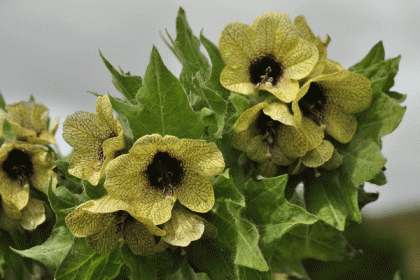A distinctive, evil-smelling but handsome plant, Henbane is not too widely found in Ireland. Either annual or biennial, it grows principally on disturbed, bare and coastal, shingly land. It's a tall plant, reaching up to 80 cm high, and erect stout stems bear curved, one-sided leafy spikes of trumpet shaped cream-yellow flowers (20-30 mm). At the heart of each flower lies a deep dark-purple centre and an amazing tracery of purple veins spreads from this centre up into the five surrounding lobes. This plant blooms from May to August. Oval, pointed leaves form a rosette in the first year with upper leaves clasping the stem in the second year. The leaves and the stem are covered with sticky hairs and the entire plant has an unpleasant, sickly smell. A native plant, it belongs to the Solanaceae family.
I first recorded this species in County Wexford in 2011 where I also photographed it. I am most grateful to Paul Green, BSBI Vice-County Recorder for Counties Waterford and Wexford who showed me the plant’s basal rosette in autumn of 2010.
If you are satisfied you have correctly identified this plant, please submit your sighting to the National Biodiversity Data Centre




